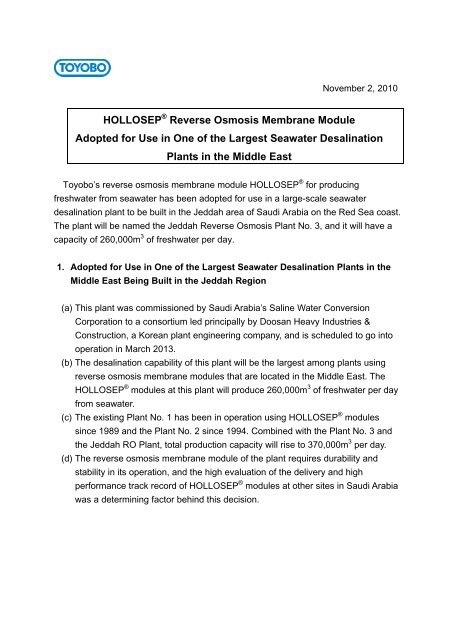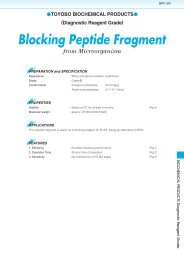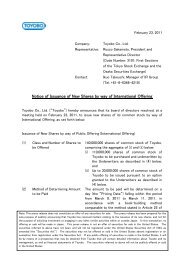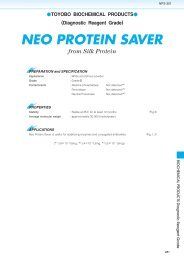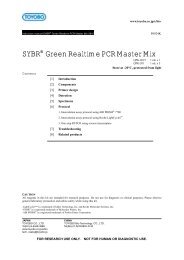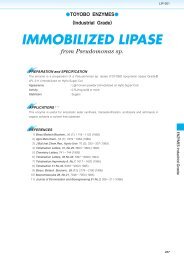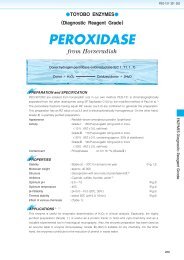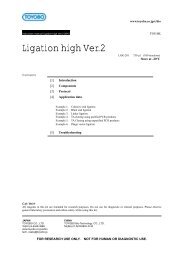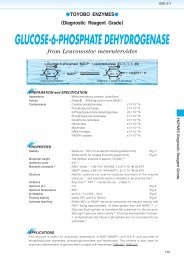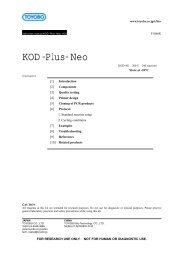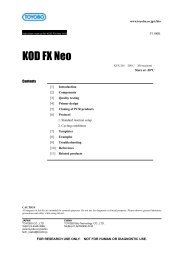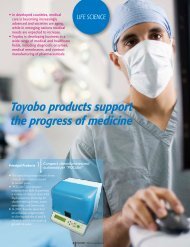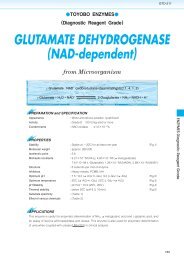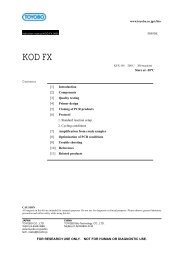HOLLOSEP® Reverse Osmosis Membrane Module ... - Toyobo
HOLLOSEP® Reverse Osmosis Membrane Module ... - Toyobo
HOLLOSEP® Reverse Osmosis Membrane Module ... - Toyobo
You also want an ePaper? Increase the reach of your titles
YUMPU automatically turns print PDFs into web optimized ePapers that Google loves.
November 2, 2010<br />
HOLLOSEP ® <strong>Reverse</strong> <strong>Osmosis</strong> <strong>Membrane</strong> <strong>Module</strong><br />
Adopted for Use in One of the Largest Seawater Desalination<br />
Plants in the Middle East<br />
<strong>Toyobo</strong>’s reverse osmosis membrane module HOLLOSEP ® for producing<br />
freshwater from seawater has been adopted for use in a large-scale seawater<br />
desalination plant to be built in the Jeddah area of Saudi Arabia on the Red Sea coast.<br />
The plant will be named the Jeddah <strong>Reverse</strong> <strong>Osmosis</strong> Plant No. 3, and it will have a<br />
capacity of 260,000m 3 of freshwater per day.<br />
1. Adopted for Use in One of the Largest Seawater Desalination Plants in the<br />
Middle East Being Built in the Jeddah Region<br />
(a) This plant was commissioned by Saudi Arabia’s Saline Water Conversion<br />
Corporation to a consortium led principally by Doosan Heavy Industries &<br />
Construction, a Korean plant engineering company, and is scheduled to go into<br />
operation in March 2013.<br />
(b) The desalination capability of this plant will be the largest among plants using<br />
reverse osmosis membrane modules that are located in the Middle East. The<br />
HOLLOSEP ® modules at this plant will produce 260,000m 3 of freshwater per day<br />
from seawater.<br />
(c) The existing Plant No. 1 has been in operation using HOLLOSEP ® modules<br />
since 1989 and the Plant No. 2 since 1994. Combined with the Plant No. 3 and<br />
the Jeddah RO Plant, total production capacity will rise to 370,000m 3 per day.<br />
(d) The reverse osmosis membrane module of the plant requires durability and<br />
stability in its operation, and the high evaluation of the delivery and high<br />
performance track record of HOLLOSEP ® modules at other sites in Saudi Arabia<br />
was a determining factor behind this decision.
2. Features of HOLLOSEP ®<br />
(a) HOLLOSEP ® modules employ cellulose triacetate hollow fiber membranes that<br />
provide superior resistance to chlorine, which is injected in the water to prevent the<br />
growth of microorganisms and algae. These modules have demonstrated<br />
excellent operating performance at many plants in Japan and around the world.<br />
(b) HOLLOSEP ® modules have been adopted for use in the world’s largest seawater<br />
desalination plants located in Saudia Arabia: namely, the Shuqaiq Plant (with a<br />
capacity of 240,000m 3 per day), the Rabigh Plant (220,000m 3 per day) and the<br />
Yanbu Plant (130,000m 3 per day). In the Middle East, where there is a strong need<br />
for desalinated water, HOLLOSEP ® modules boast a greater-than-50% share of<br />
the market for seawater desalination modules.<br />
For more information, contact:<br />
<strong>Toyobo</strong> Public Relations Group<br />
pr_g@toyobo.jp
[Supplement]<br />
Major Seawater Desalination Plants Employing HOLLOSEP ® <strong>Module</strong>s<br />
Plant Name (Country) Plant Size Start-up Date<br />
Jeddah RO3 (Saudi Arabia) 260,000 m 3 /day 2013<br />
Shuqaiq-II (Saudi Arabia) 240,000 m 3 /day 2010<br />
Rabigh (Saudi Arabia) 218,000 m 3 /day 2008<br />
Yanbu (Saudi Arabia) 128,000 m 3 /day 1998<br />
Jubail (Saudi Arabia) 66,700 m 3 /day 2007<br />
Jeddah RO1 (Saudi Arabia) 56,800 m 3 /day 1989<br />
Jeddah RO2 (Saudi Arabia) 56,800 m 3 /day 1994<br />
MARAFIQ- Yanbu (Saudi Arabia) 50,400 m 3 /day 2005<br />
Fukuoka (Japan) 50,000 m 3 /day 2005<br />
Ad Dur (Bahrain) 45,500 m 3 /day 2005<br />
Florida (USA) 11,400 m 3 /day 2005<br />
Tanjun-Jati B (Indonesia) 10,800 m 3 /day 2005


